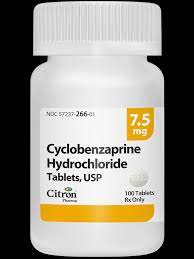Cyclobenzaprine: Uses, Dosage Side effects, Warnings

Cyclobenzaprine is in a class of medications called skeletal muscle relaxants. It is a centrally-acting muscle relaxant that works by acting in the brain and nervous system to allow the muscles to relax.
This drug was first synthesized in 1961 and became available for human use in 1977. It was initially studied for use as antidepressant given its structural similarity to tricyclic antidepressants – it differs from Amitriptyline by only a single double bond.
Cyclobenzaprine is used with rest, physical therapy, and other measures to relax muscles and relieve pain and discomfort caused by strains, sprains, and other muscle injuries.
What form(s) does this medication come in?
Each butterscotch yellow, film-coated, D-shaped tablet, engraved “APO” over “10” on one side, contains 10 mg of cyclobenzaprine. Nonmedicinal ingredients: carnauba wax, colloidal silicon dioxide, cornstarch, hydroxypropyl methylcellulose, lactose, magnesium stearate, microcrystalline cellulose, polyethylene glycol, titanium dioxide, and yellow ferric oxide.
How should I use Cyclobenzaprine?
The usual adult dose of cyclobenzaprine is 10 mg 3 times a day, with a range of 20 mg to 40 mg a day (given in divided doses). The total dose should not exceed 60 mg daily. Use of this medication is not recommended for periods longer than 2 or 3 weeks.
Many things can affect the dose of medication that a person needs, such as body weight, other medical conditions, and other medications. If your doctor has recommended a dose different from the ones listed here, do not change the way that you are taking the medication without consulting your doctor.
It is important to take this medication exactly as prescribed by your doctor. If you miss a dose, take it as soon as possible and continue with your regular schedule. If it is almost time for your next dose, skip the missed dose and continue with your regular dosing schedule. Do not take a double dose to make up for a missed one. If you are not sure what to do after missing a dose, contact your doctor or pharmacist for advice.
Store this medication at room temperature, protect it from light and moisture, and keep it out of the reach of children.
Do not dispose of medications in wastewater (e.g. down the sink or in the toilet) or in household garbage. Ask your pharmacist how to dispose of medications that are no longer needed or have expired.
Who should NOT take this medication?
Do not take this medication if you:
• are allergic to cyclobenzaprine or any ingredients of this medication
• are in the acute recovery phase of heart attack
• are taking MAO inhibitors (such as phenelzine or tranylcypromine) or have taken them in the past 14 days
• have abnormal heart rhythms
• have an overactive thyroid gland (hyperthyroidism)
• have congestive heart failure
• have heart block or conduction disturbances
What side effects are possible with this medication?
Many medications can cause side effects. A side effect is an unwanted response to a medication when it is taken in normal doses. Side effects can be mild or severe, temporary or permanent.
The side effects listed below are not experienced by everyone who takes this medication. If you are concerned about side effects, discuss the risks and benefits of this medication with your doctor.
The following side effects have been reported by at least 1% of people taking this medication. Many of these side effects can be managed, and some may go away on their own over time.
Contact your doctor if you experience these side effects and they are severe or bothersome. Your pharmacist may be able to advise you on managing side effects.
• blurred vision
• difficulty sleeping
• dizziness
• drowsiness
• dry mouth
• fatigue
• headache
• indigestion
• nausea
• sweating
• unpleasant taste
• weakness
Although most of the side effects listed below don’t happen very often, they could lead to serious problems if you do not seek medical attention.
Check with your doctor as soon as possible if any of the following side effects occur:
• abdominal pain
• agitation
• confusion
• constipation
• difficulty urinating
• hallucinations (seeing or hearing things that aren’t there)
• increased heart rate or fast heartbeat
• lack of muscle coordination or clumsiness
• sensations of tingling, burning, or numbness
• shortness of breath
• signs of depression (e.g., poor concentration, changes in weight, changes in sleep, decreased interest in activities, thoughts of suicide)
• symptoms of glaucoma (e.g., blurred vision, seeing halos of bright colours around lights, red eyes, increased pressure in your eyes, eye pain or discomfort)
• trembling
Stop taking the medication and seek immediate medical attention if any of the following occur:
• fainting
• symptoms of overdose
o dry, hot, flushed skin
o fast or irregular heartbeat
o hallucinations
o increase or decrease in body temperature
o seizures
o severe drowsiness
o troubled breathing
o unexplained muscle stiffness
o vomiting occurring together with other symptoms of overdose
• symptoms of serious allergic reaction
o changes in the skin colour of the face
o fast or irregular breathing
o large swellings that look like hives on the face, eyelids, mouth, lips, and/or tongue
o puffiness or swelling of the eyelids or the area around the eyes
o shortness of breath
o skin rash, hives, or itching
o tightness in chest
o trouble breathing
o wheezing
• symptoms of serotonin syndrome
o confusion
o fast heartbeat
o hallucinations
o restlessness
o shaking
o shivering
o sudden jerking of muscles
o sweating
Some people may experience side effects other than those listed. Check with your doctor if you notice any symptom that worries you while you are taking this medication.
Cyclobenzaprine Safety Information
You should not use cyclobenzaprine if you have an allergy to the medication, a certain type of thyroid disorder (hyperthyroidism), heart block, congestive heart failure, a heart rhythm disorder, or you have recently had a heart attack.
Do not use cyclobenzaprine if you have taken an MAO inhibitor in the past 14 days, such as isocarboxazid, linezolid, phenelzine, rasagiline, selegiline, or tranylcypromine.





